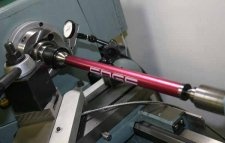Ok that’s what I figured you had. I’ve used the same thing, they are useful.
You can insert the MT end into tailstock as you alluded, rotate a chuck mounted DTI about the end & measure deviation relative to head stock spindle axis. But there are a few important steps that should precede this, otherwise the test could be somewhat invalid. I’ll explain what I did & why, see if makes sense. If you spot logic flaws, let me know.
Test-1. Putting aside micron level specs for now, let’s just assume test bar is sufficiently accurate for lathe setup work, which it probably is. Insert test bar MT end into your headstock socket. If headstock is MT5 you need an accurately ground MT5/MT3 adapter sleeve, everything squeaky clean, no scratches or debris etc. Attach mag base to lathe way & DTI ball on outer portion of test bar. Rotate spindle. Any needle deflection tells you ‘something’ about spindle bearings & health of female MT socket. Unfortunately 'something' it’s a combo of factors, but ideally should be quite small on a tight lathe. Some may even suggest it’s not valid on a cold lathe, the bearings should be at running temp & pre-load.
Test-2, very important for actual turning work. Attach mag base to carriage, DTI ball on outboard portion of test bar for maximum resolution, centered at 9:00 position viewing test bar from end. Bar is stationary in this test. Traverse carriage full length of cylindrical test bar section. Any DTI needle deflection is showing you head stock misalignment relative to the way axis, which means your lathe will be cutting a slight taper even assuming perfect work holding. Correct this. My lathe has adjuster jack screws. If you breathe on them wrong it’s back to the drawing board. If the lathe is an integrated head / bed uni-casting, that might be the end of the trail. This is also where people get into evaluating lathe bed twist by jacking the feet, sometimes called lathe leveling (which is kind of a misnomer). Bed twist can interact the same way in terms of yielding tapered cutting. But headstock misalignment in plan view is the more dominant issue to correct. Similarly if the DTI ball is on top of the bar at 12-oclock position & carriage traversed, this indicates headstock axis is pointing up or down relative to bed. I’m not sure how to correct this aside from very subtle shimming. It will also cut a taper but a lesser amount.
Test-3. With headstock aligned and/or bed leveled as much as possible, NOW you can proceed to tailstock. So yes, you can put test bar MT end into TS socket, rotate a DTI about this & it will indicate TS axis misalignment in both up/down & left/right axis. Up/down is less problematic but left/right should be resolved otherwise you are drilling, reaming, supporting work off center - all bad. There is another gadget that does this between centers (made by Edge). That’s a static measurement, so eliminates headstock bearing stuff. Make sure the TS & barrel is locked down. Also do the test at retracted & extended positions. Now consider test-2 again. If the headstock was out & TS axis was perfectly aligned to bed, this combination would also show DTI needle deflection... but for the wrong reason. So there is a sequential order.
All this & we still haven’t talked about chucks yet. That’s because the underlying axis geometry must be validated first; the chuck is going along for the ride. Assuming chuck fits spindle nose correct & no issues with D1-4 or whatever the retention mechanism is, we get to chuck gripping. A 3-jaw scroll chuck might have like 0-1 thou TIR on freshly ground jaws or a Set-Tru type setup. An ordinary chuck on an ordinary lathe might be 2-3 thou. A worn out Betsy… maybe 4+ thou. But even gripping a perfect TIR hardened dowel in a 3J, you could get different repeat TIRs of +/- 0.0005” based on the stock diameter, clamping force, unequal torque on each key socket & other variables. Collet chucks are better than this, but sub-1-thou is considered pretty good for a hobby machine.
So…. this is why I was asking about your intended tests. If you are wanting to validate the micron accuracy of the bar, that’s might be lab level stuff. If you are wanting to use bar for lathe setup, there are likely bigger tolerances at play. Micron level is great but not necessary because you are magnifying alignment via the length of the bar. Therefore the bigger question is how straight is it?




